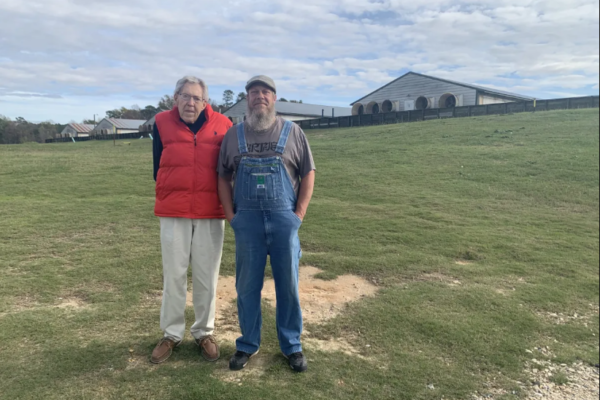By: Lisa Sorg, NC Policy Watch
November 24, 2020
In an extraordinary concurring opinion, a Reagan-appointed judge offers searing indictment of industrialized hog farming
Shortly after Smithfield Foods lost its third consecutive hog nuisance case in federal court, company CEO Ken Sullivan wrote a letter. In it, Sullivan reassured the company’s employees and contract growers that while Smithfield faced tens of millions of dollars in damages to neighbors of the offending farms, as well as untold legal fees, the Fourth Circuit Court of Appeals would bend the arc of justice back their way.
“Since the early stages of these cases, we’ve believed North Carolina law is on our side,” Sullivan wrote in August 2018, “and the real case about the plaintiffs and their properties has been buried in an avalanche of distraction, manipulation and manufactured evidence.”
Smithfield would never settle, company officials often said.
Now Smithfield is settling.
Last week the federal appeals court, in a 2-1 decision, sided with the neighbors. Judges found just one snowflake in the so-called avalanche, ordering that a jury recalculate punitive damages without the consideration of company officials’ multi-million-dollar salaries. The rest of the plaintiffs’ arguments were upheld.
Judge Stephanie Thacker, an Obama appointee, wrote the opinion that systematically dismantled Smithfield’s legal claims.
G. Steven Agee, appointed by George W. Bush, contributed a vigorous dissent, saying he would have ordered a new trial.
But the concurrence, written by conservative justice J. Harvie Wilkinson III was tantamount to an indictment of the entire industrialized hog industry. Over 14 pages, Wilkinson, a Reagan appointee, commiserated with the neighbors, the majority of whom are Black, Latinx or low-income. He empathized with the millions of hogs raised in dark, crowded, filthy barns without ever touching grass or seeing the full glow of the sun.
“I am also not so naive as to imagine that hog farming could ever be an antiseptic enterprise,” Wilkinson wrote. “But the record here reveals outrageous conditions at Kinlaw Farms” — the first of dozens of Smithfield’s operations under scrutiny.
“How did it come to this?” Wilkinson wrote. “What was missing from Kinlaw Farms — and from Murphy-Brown” — a Smithfield subsidiary — “was the recognition that treating animals better will benefit humans. What was neglected is that animal welfare and human welfare, far from advancing at cross-purposes, are actually integrally connected.”
Throughout the 18 months that the trials unfolded in U.S. District Court in Raleigh, many state lawmakers from eastern North Carolina, as well as Agriculture Commissioner Steve Troxler, publicly bemoaned that consumers don’t know where their food comes from. In reality, such statements are code, a catchy shorthand to demonstrate the inferiority of city dwellers to country folk, the salt of the earth.
But Troxler, State Rep. Jimmy Dixon and State Sen. Brent Jackson have a point. Many consumers, regardless of where they live, don’t know the full story of where their food comes from. They don’t know about the flies, stench, vultures, “dead boxes,” truck traffic and the fecal particles that drift from the spray fields onto neighbors’ properties, all of which contribute to higher-than-average rates of respiratory illnesses and psychological stress in these communities.
They are shielded from the brutality of industrialized agriculture because behemoth companies like Smithfield deploy PR campaigns that scrub the gore from images of concentrated feeding operations. Instead of the truth — court exhibits showed feces-encrusted hogs crammed into suffocating barns too tight to accommodate the animals’ rapidly expanding girth — consumers see shiny pink piglets being cradled in a farmer’s arms.
“Charlotte’s Web reminds us that all life is interconnected,” Wilkinson wrote. “And while not all pigs will be pardoned like Wilbur, it is fitting that the creatures who give their very lives for us, receive in return our efforts to make their brief stay on earth less intolerable. For their sake and ours. Such is the web of life.”
The juries’ verdicts and the appeals court’s upholding of them should signal a reckoning for North Carolina’s hog industry. “It is past time to acknowledge the full harms that the unreformed practices of hog farming are inflicting,” Wilkinson wrote.
Industry P.R. paints a different picture
The acknowledgments of which Wilkinson wrote are missing from “High on the Hog,” a historical exhibit that opened last fall at the Museum of the Albemarle in Elizabeth City. (It runs through September 2022.)

A crimson-stained butcher’s table, a Remington rifle used to shoot pigs destined for the dinner plate, a tin of pork brains in milk gravy: All of these accoutrements hearken to a simpler era of animal agriculture. The hogs’ deaths were indeed brutal. But modern agriculture methods sustain that brutality throughout the animals’ lives, with death as a merciful release.
In fact, a small placard was the museum’s only nod to industrialization, what Wilkinson described in his opinion as “the pasture-to-CAFO transition … that bred horrible outcomes for pigs and humans alike.”
In sanitized prose the placard read, “In the 21st century, few self-sustaining farms exist. Rather farmers are raising great quantities of pigs to sell to large pack-and slaughterhouses.”
Again, the neighbors and workers have been erased.
The exhibit’s opening ceremonies featured Marlowe Vaughan, a fourth-generation farmer and executive director of Feed the Dialogue NC, a front group backed by the North Carolina Farm Bureau.
Vaughan, who is white, tried to reassure the audience that the barbecue they were about to eat came from a happy pig. “I care about how they feel and raising a healthy product for the consumer,” she said of the 7,200 pigs she raises on her Lenoir County farm. “We’re doing everything we can do as farmers to make sure they’re living their best quality of life.”
She justified growing swine in confined barns, calling the method “improved housing and sanitation.”
“If you’re raising hogs on the ground, they use the bathroom and cause environmental problems,” she said.
But the lagoon and sprayfield system is essentially the same process, with a modicum of human intervention. The manure and urine flow through slats in the barn floor, then are flushed into open lagoons and sprayed via irrigation onto farm fields. The air, groundwater and in some cases, surface water carry that contamination off the farm and onto neighboring properties — and even further downstream.

“High on the Hog” opened four months before the first known case of COVID-19 in the U.S. In his concurring opinion, Wilkinson made the connection between animal and human infections, known as zoonotic disease, which can start in a small area, like a livestock farm or in the case of COVID-19, a bat cave, and quickly spread among species, including humans.
The swine flu outbreak of 2009, for example, incubated and mutated in pigs before killing 12,500 people and hospitalizing another 275,000 in the U.S. Higher rates of MRSA infection, an antibiotic-resistant staph bacteria, have been found on the skin and in the nasal passages of livestock workers and their families.
“In any future pig-to-human transmission, individuals working directly with affected pigs at facilities like Kinlaw are likely to be among the first infected,” Wilkinson wrote, “followed shortly thereafter by other members of their community. … The problem’s impact on pigs is only the first link in a longer chain that wraps around workers and the surrounding homeowners.”
“At the end of all this wreckage lies an uncomfortable truth,” Wilkinson wrote. “These nuisance conditions were unlikely to have persisted for long — or even to have arisen at all — had the neighbors of Kinlaw Farms been wealthier or more politically powerful.”

Can this industry be saved?
Smithfield says it is addressing the problems caused by the lagoon and sprayfield system via a new project with Dominion Energy: The Align RNG biogas pipeline involving 19 farms in Duplin and Sampson counties.
The companies have kept secret not only the pipeline route, but also the names of 15 of 19 farms that will participate. Yet, of those that have been disclosed, two are Murphy-Brown’s corporate farms named in the nuisance lawsuits — Benson Farm and Farm 2037 & 2038. Two more farms involved in the litigation lie within the pipeline route: H&C and NBH, both in Turkey.
The proposal calls for farms to install anaerobic digesters, which will capture and pipe methane, a potent greenhouse gas, through a 30-mile pipeline to Align RNG’s upgrading plant between Warsaw and Turkey. From there, the company will tap into the main line owned by Piedmont Natural Gas so that the upgraded gas can be combined with traditional natural gas for energy use.
However, the farms will still have secondary lagoons to store effluent from the digesters. And the farms will still spray feces and urine on their fields. It’s likely that odors will be reduced but not eliminated; the outdated waste management system is essentially unchanged.
Last week the NC Department of Environmental Quality held a virtual public meeting and hearing about the proposal.
Opponents are concerned that nuisances from the lagoons and spray fields will continue, disguised and justified as “renewable energy.” Furthermore, Align RNG has asked utility officials to exempt its low-pressure pipeline from regulatory oversight, further burdening communities that have higher percentages of Black, Latinx and low-income residents than the state average.
“This is just another Smithfield get-rich scheme,” said Belinda Joyner, a community organizer with Clean Water for North Carolina in Northampton County.
The business community cited Align RNG’s reported $375 million investment over 10 years, including tax revenue from its biogas upgrading facility along NC Highway 24 on the Duplin-Sampson county line. The project will create 25-30 temporary jobs and just two permanent ones.
What the business leaders from community colleges and economic development offices didn’t say is that a UNC study published in 2013 showed that in Sampson County, local governments have lost millions of dollars in property tax revenue because of the decline in value of homes near hog lagoons.
The UNC study estimated that Sampson County and its local governments lose $450,000 to $1.3 million each year in property tax revenue. In the entire 10-county region where most of North Carolina’s hogs are raised, the losses range from $1.5 million to $6 million annually.
The study found that after accounting for size and age of a home, its proximity to a hog lagoon results in a nearly $11,000 reduction in its assessed value. For parcels without houses, that decline is nearly $5,500.
“…whether a home borders a golf course or a dirt road, it is a castle for those who reside in it,” Judge Wilkinson wrote. “It is where children play and grow, friends sit and visit, and a life is built. … Murphy-Brown’s interference with their quiet enjoyment of their properties was unreasonable. It was willful, and it was wanton.”





